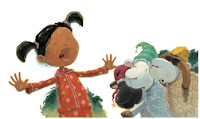Title: Sometimes I Like to Curl up in a Ball
Vicki Churchill (Author)
Charles Fuge (Illustrator)
Arts Modality: creative movement
Reading Strategies: inferring, making connections
Summary: Little wombat spends a day doing favorite things--what could they be? Are they your favorites, too? Let's look and see! He especially enjoys walking around and around, and doing a pigeon step till he falls down. Or sticking out his pink tongue--and pulling funny faces (now that can be fun)! And maybe he'll jump just as high as he can, and see how much noise he will make when he lands. But when the day ends and the sun starts to fall...he goes back home to mama and curls into a ball. Good night! (Summary from Sterling Children's Books.)
Materials:
Sometimes I Like to Curl up in a Ball
Lesson:
Do you ever feel like curling up in a ball? Or maybe jumping as high as you can? Either way, you and your little listeners are sure to connect with the feelings of the toddler-like wombat in Sometimes I Like to Curl up in a Ball.
In this charmingly illustrated book, the wombat and his woodland friends spend the day doing some of their favorite things, such as jumping, walking around, falling down, and just standing still. Along with all the romping and rolling, there's rhyming as well. The simple rhyming phrases are easy for little ones to listen to, repeat, and understand. In much the same way, the simple movements are easy for young movers to watch, mimic, and enjoy.
Begin your story time by simply asking the children, "Have you ever wanted to curl up in a ball?" Go ahead. Let them wrap their arms around their legs and curl up into balls. Next explore the feelings that would make someone want to curl up so small that no one could see him or her, like the combat wants to do in the beginning of the book.
Continue this exploration of emotions with a picture walk through the book. Invite the children to look carefully at the wombat's facial expressions on each spread. Also consider the expressions of his companions. What feelings and situations would make them want to move the different ways they move in the book?
After you've used the illustrations to infer the animal's feelings, invite listeners to connect to the text through movement. Help the children find their own spaces. As you read each rhyming phrase, allow the children to copy the wombat's actions. Help them describe his movements. Where are his arms? Do his legs go in the same direction every time? When is his body up high? When is it down low?
As you read, children can:
- Curl up in a ball
- Jump high
- Walk round and round
- Fall down
- Stand still
- Make funny faces
- “Play” in mud
- Run fast
- Curl up in a ball and “sleep”
If you feel like reading another book that connects emotions with movements, try Sometimes I Feel Like a Mouse: A Book about Feelings by Jeanne Modessitt and Robin Spowart. Another good pairing is with Quick as a Cricket by Audrey and Don Wood.








































